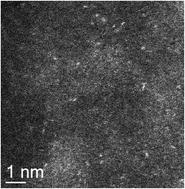当前位置:
X-MOL 学术
›
Faraday Discuss.
›
论文详情
Our official English website, www.x-mol.net, welcomes your
feedback! (Note: you will need to create a separate account there.)
Spiers Memorial Lecture: Understanding reaction mechanisms in heterogeneously catalysed reactions
Faraday Discussions ( IF 3.3 ) Pub Date : 2021-3-16 , DOI: 10.1039/d1fd00023c Graham J Hutchings 1
Faraday Discussions ( IF 3.3 ) Pub Date : 2021-3-16 , DOI: 10.1039/d1fd00023c Graham J Hutchings 1
Affiliation

|
Heterogeneous catalysis lies at the heart of the chemical and fuel manufacturing industries and hence is a cornerstone of many economies. Many of the commercially operated heterogeneous catalysts have remained basically unchanged for decades, undergoing small but important optimisation of their formulations. Yet we all acknowledge that there is a continuous drive towards improved catalysts or designing new ones. At the heart of these studies has been the need to gain an improved understanding of the reaction mechanism for these important reactions since this can unlock new ways to improve catalyst design and, of course, the ultimate aim is to design catalysts based on the detailed understanding of the reaction mechanism. These advanced studies have been aided in the last decade by two key factors, namely: (a) access to advanced characterisation techniques based on synchrotron methods and aberration-corrected microscopy that can probe the nature of the active site, and (b) the application of high-level computational methods to understand how the reactants and products interact at the active site. In this paper this theme will be explored using two examples to bring out the complexity in gaining an understanding of a reaction mechanism. Using the zeolite H-ZSM-5 as an example of a single site catalyst, the mechanism of the conversion of methanol to the first hydrocarbon carbon–carbon bond will be discussed. In this section the use of model reactants and reaction probes will be used to try to differentiate between different mechanistic proposals. The second example explores the use of gold catalysts for CO oxidation and acetylene hydrochlorination. In both these examples the importance of advanced characterisation and theory will be highlighted.
中文翻译:

Spiers 纪念讲座:了解多相催化反应中的反应机制
多相催化是化学和燃料制造业的核心,因此是许多经济体的基石。许多商业操作的多相催化剂几十年来基本保持不变,对其配方进行了小而重要的优化。然而,我们都承认,不断推动改进催化剂或设计新催化剂。这些研究的核心是需要更好地了解这些重要反应的反应机理,因为这可以开启改进催化剂设计的新方法,当然,最终目标是基于详细了解设计催化剂反应机理。在过去十年中,这些高级研究得到了两个关键因素的帮助,即:(a) 使用基于同步加速器方法和像差校正显微镜的先进表征技术,可以探测活性部位的性质,以及 (b) 应用高级计算方法来了解反应物和产物如何在活性部位相互作用地点。在本文中,将使用两个例子来探讨这个主题,以揭示理解反应机制的复杂性。使用沸石 H-ZSM-5 作为单中心催化剂的例子,将讨论甲醇转化为第一个碳氢碳键的机理。在本节中,将使用模型反应物和反应探针来尝试区分不同的机制建议。第二个例子探讨了使用金催化剂进行 CO 氧化和乙炔氢氯化。
更新日期:2021-04-16
中文翻译:

Spiers 纪念讲座:了解多相催化反应中的反应机制
多相催化是化学和燃料制造业的核心,因此是许多经济体的基石。许多商业操作的多相催化剂几十年来基本保持不变,对其配方进行了小而重要的优化。然而,我们都承认,不断推动改进催化剂或设计新催化剂。这些研究的核心是需要更好地了解这些重要反应的反应机理,因为这可以开启改进催化剂设计的新方法,当然,最终目标是基于详细了解设计催化剂反应机理。在过去十年中,这些高级研究得到了两个关键因素的帮助,即:(a) 使用基于同步加速器方法和像差校正显微镜的先进表征技术,可以探测活性部位的性质,以及 (b) 应用高级计算方法来了解反应物和产物如何在活性部位相互作用地点。在本文中,将使用两个例子来探讨这个主题,以揭示理解反应机制的复杂性。使用沸石 H-ZSM-5 作为单中心催化剂的例子,将讨论甲醇转化为第一个碳氢碳键的机理。在本节中,将使用模型反应物和反应探针来尝试区分不同的机制建议。第二个例子探讨了使用金催化剂进行 CO 氧化和乙炔氢氯化。











































 京公网安备 11010802027423号
京公网安备 11010802027423号